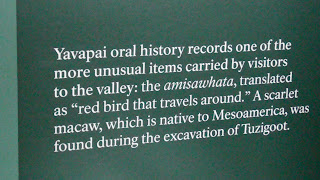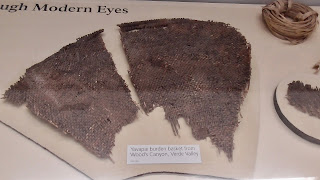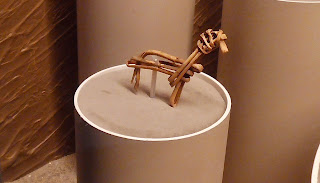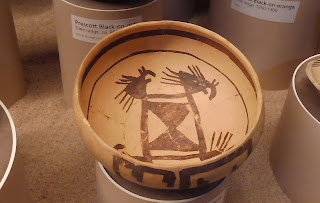Welcome to Tuzigoot Nat'l Monument
Tuzigoot (pronounced tu z goot) and other pueblos throughout the
Verde Valley were occupied for hundreds of years, longer than the
United States had been a country. They thrived and prospered.
But in the late 1300’s they began to leave...
Tuzigoot is Apache for “crooked water", and is the remnant of a Southern Siaqua
village built between 1000 and 1400.
Today, many of the artifacts uncovered by Caywood and Spicer are on display
in the Tuzigoot Museum Collection. Built in 1936, the museum was
designed specifically to echo the construction techniques used in the
Tuzigoot pueblo. All but a handful of the artifacts on display in the
museum were found here on site, and all of them allow us tiny glimpses into
the daily life, work, and art of people who built these walls
a thousand years ago. Let’s look inside the museum.
began using a highly select clay source and a new coal-firing technique
to create fine yellow wares. The clay was fired at high temperatures in
an oxidizing environment to produce a creamy yellow base color and dense
ceramic wall that would nearly ring when tapped. Artisans decorated
these yellow wares with geometric and abstract designs executed with
contrasting iron-based (iron and manganese oxide) pigments, as visible here.
Jeddito Yellow Ware vessels generally present a select repertoire
of geometric and figural motifs, including birds and flowers.
the sound with you...
The human history of the Verde Valley begins around ten thousand years ago,
when the southwest was cooler and wetter than it is today. Paleolithic
hunter-gatherers traveled through a greener, lusher Verde Valley,
filled with pinyon pine, shrub live oak, and juniper.
Living on hilltops, people had a line of sight between households
and could monitor their world.
By building where they did, no
farmland was sacrificed and they avoided the mosquitoes
and floods that living next to the river invited.
The first documentation of pueblos in the European-American record
dates to 1855. Antoine Leroux, a well-known mountain man
and trail guide, passed through the Verde Valley in 1854,
and reported this the following year:
"The (Verde) river banks were covered with ruins of stone houses and regular
fortifications... which had not been occupied for centuries. They built
upon the most fertile tracts of the valley and where were signs of
irrigation and cultivation.
The walls were of solid masonry, of rectangular form, some
twenty or thirty paces in length, and yet remaining ten
or fifteen feet in height."
























No comments:
Post a Comment